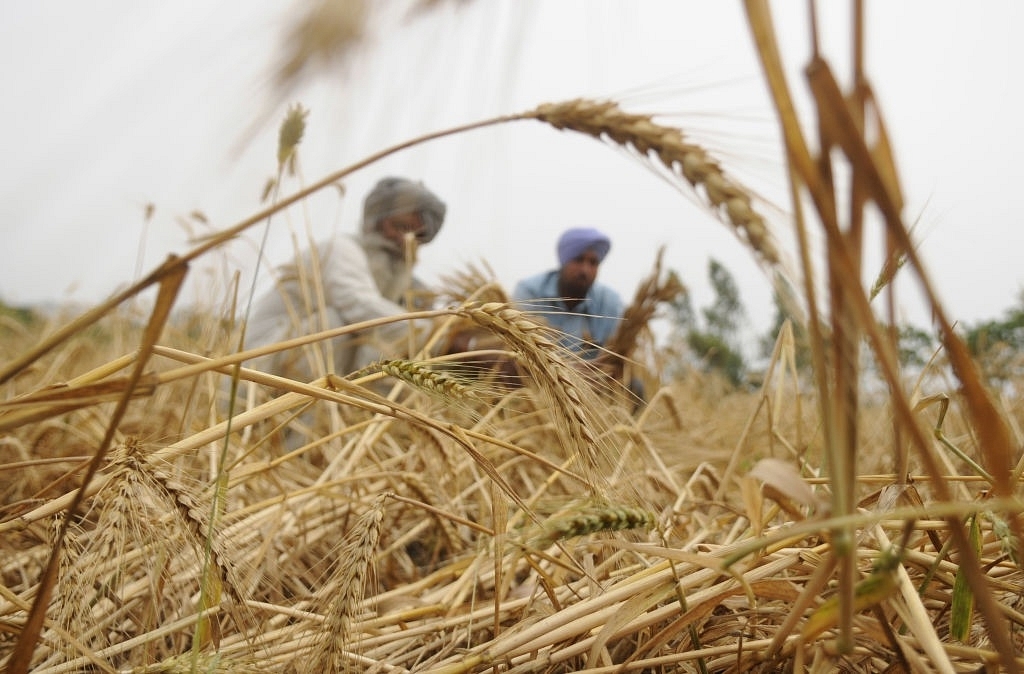Economy
Kisan Decision Support System - Come This Kharif, Agri Ministry To Rollout Nation-Wide Demand Forecasting System For Crops And Veggies
- The new system will be modelled on the seasonal weather forecasting system of the India Meterological Department.

Wheat farmers in India. (Bharat Bhushan/Hindustan Times via Getty Images)
Beginning next Kharif season, the Union Agriculture Ministry will roll out a nation-wide, agri market intelligence system with the objective of helping farmers secure better price by forecasting demand for major foodgrains and price-sensitive horticulture crops such as onions, The Hindu Business Line has reported.
A forecasting system well ahead of the production season can enable the farmers to make an informed decision on their production with a view to earning optimal returns. The forecasting system is also expected to help other stakeholders in the agri-supply system including traders, processors, exporters, importers.
Quoting an official in the Agriculture Ministry, The Hindu Business Line report said that the proposed system will be exactly modelled on the seasonal weather forecasting system of India Meterological Department’s (IMD). Regular forecasts will be issued on a fortnightly basis during the sowing season through the system and the initial scope will include foodgrains — which cover 72 per cent of total cropped area in the country and horticulture crops such as potatoes, onions and tomatoes.
Setting up a system for forecasting price and demand for agricultural commodities is based on the recommendations made by an expert panel on doubling farmers’ income, headed by Ashok Dalwai, who is also the CEO of National Rainfed Area Authority (NRAA). The Dalwai Committee, set up in April 2016, has submitted a14 -volume report identifying ways to double farmers’ 2015-16 income level, in real terms, by 2022.
The Dalwai committe had observed that over the years, though the government has developed an elaborate system of estimation of crop sown area, yield and production of different crops, quality and timeliness of the data poses a big challenge in precise and error free forecasting and projections. It also pointed out that despite multiple organisations involved in compilation, monitoring and release of prices/price indices, currently no department is involved in forecasting prices/demand officially at the national level. The committe had recommended restructuring of Directorate of Marketing Inspection into the Directorate of Marketing Intelligence to help provide a solution at national level for reliable and timely price forecasting in a sustainable way. The committee also recommended that focus should be on monitoring demand and supply situations to arrive at associated price forecast.
The Dalwai commitee had underscored the need for designing a multivariate forecasting system for price of an agriculture commodity using a dynamic model that, in addition to historical prices, incorporates all possible explanatory factors including yield, rainfall, temperature, stocks, trade (imports and exports), unforeseen factors like political uncertainty, strikes, etc., that influence future price and production of a commodity.
In October this year, the Agriculture Ministry constituted a technical advisory committee (TAC), again under the chairmanship of Dalwai.
According to The Hindu Business Line report, the Indian Council of Agricultural Research (ICAR-NIAP) has been identified as knowledge partner for the project to begin with. The TAC, from time to time, would recommend commodities on which price and demand forecasting needs to be made by ICAR-NIAP. The TAC is likely to sign a memorandum of understanding with some agricultural universities in the country and also set up centres in different places so that regional forecasts can be made.
The Dalwai Committe report also showcased few success stories in building a price forecasting system for agricultural commodities.
In 2015-16 in Karnataka, with financial assistance from Karnataka State Agriculture Marketing Board, three agriculture universities located at Bengaluru, Dharwad and Raichur were assigned the project of developing a price forecasting system using rigorous time series econometric models for select commodities including paddy, sorghum, maize and ragi under cereals; bengal gram, red gram, green gram and black gram under pulses; groundnut, sunflower and soybean under oilseeds; dry chillies, cotton, coconut, arecanut and turmeric under commercial crops; and tomato, potato and onion under vegetable crops.
Apart from forecasting, traders’ survey, consideration of future market prices, changes in the government policies, weather changes, import and export situation, prices of competitive commodities and a shift in the crop area at district, state and country levels were considered for building the model.
The government of Karnataka also constituted the Karnataka Agriculture Prices Commission (KAPC) as an advisory body to deal with aspects of scientific costing and pricing of farm produces, competitive market structure and all other issues related to farmers’ income and welfare in the state.
In order to accomplish the major mandate of timely dissemination of market intelligence and information to policy makers as well as to farmers, a project was assigned to School of Food Business, Diary Sciences College, Hebbal Campus, Bengaluru, falling under Veterinary University (KVAFSU) Bider, to construct an Interactive Dashboard for real-time prices forecast for principle agriculture and horticultural commodities. Accordingly, the dashboard was designed and developed as a ‘Decision Support System (DSS)’ with the active support a Bengaluru-based software company.
Introducing ElectionsHQ + 50 Ground Reports Project
The 2024 elections might seem easy to guess, but there are some important questions that shouldn't be missed.
Do freebies still sway voters? Do people prioritise infrastructure when voting? How will Punjab vote?
The answers to these questions provide great insights into where we, as a country, are headed in the years to come.
Swarajya is starting a project with an aim to do 50 solid ground stories and a smart commentary service on WhatsApp, a one-of-a-kind. We'd love your support during this election season.
Click below to contribute.
Latest